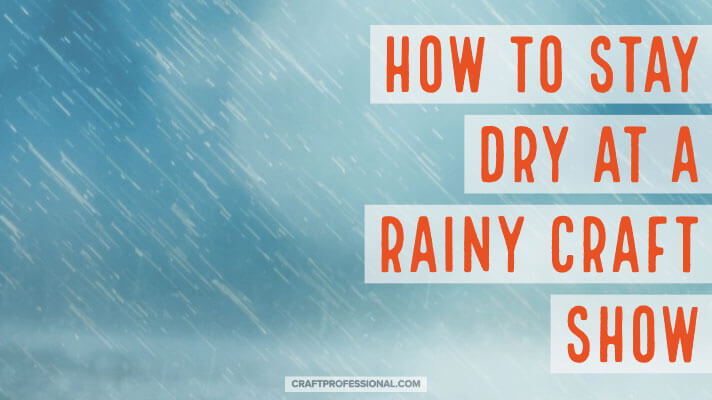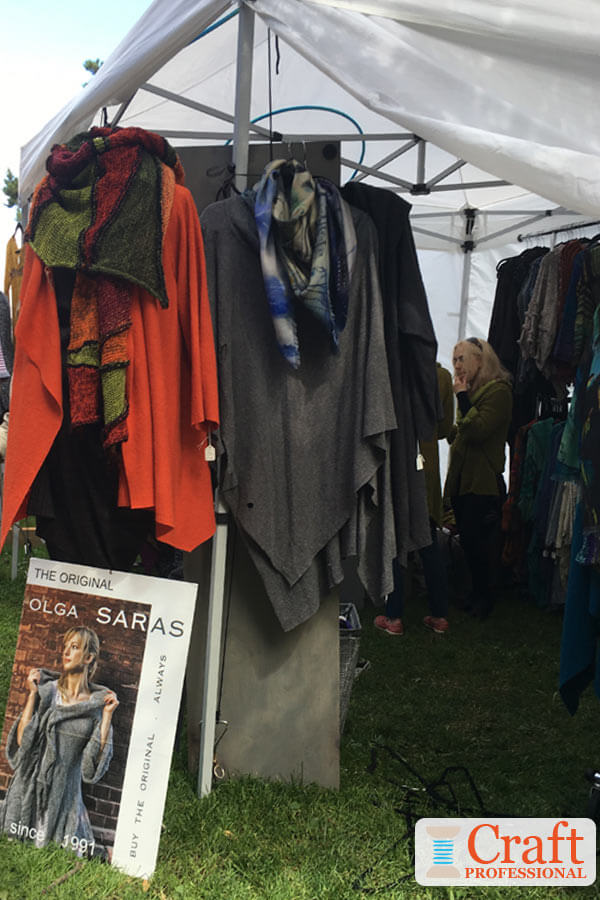Keep Your Portable Canopy Dry & Secure at Craft Shows
How to make your portable canopy more waterproof and secure. Here are strategies craft vendors use to keep water from pooling on their canopy. Also, how to keep your canopy from blowing away on a windy day.
Your portable canopy will need to protect you, your customers and your inventory from the rain at outdoor shows. You also need to ensure your tent doesn't blow off in the wind.
It's surprising how easily a small amount of wind will send a craft tent flying. Here are some strategies craft professionals use to handle the rain and wind at outdoor craft shows.

How to Stay Dry at a Rainy Outdoor Craft Show
No one wants to be at a craft show that's rained out. Customers don't show up, so sales aren't great, and you have to worry about protecting your products from being damaged in the rain.
These strategies might not help your sales at a rained out show, but they can help keep your booth and your products dry and safe. Perhaps, if your booth is clearly the driest place to be at a rainy show, you just might draw in a few more customers.
I earn a commission for purchases made through links on this page.
To learn more, please see my disclosure.
Some portable canopies do better than others when it comes to keeping out the rain. There are a few strategies you can use to help your tent stand up to wet weather, keep your products safe, and ensure you and your customers stay dry.
1. Consider applying a water repellent spray to your portable canopy.
Some people apply a water repellent spray product like Scotchgard to their canvas canopy once a year to help make it more water resistant.
If you do want to apply a water repellent to your tent, first read any care information that came with your tent. Look for information about using a water repellent spray product on your particular canopy, and take heed of any instructions or warnings.
Follow the instructions on the water repellent spray product carefully and precisely. Spray a small, inconspicuous test area first to ensure there are no problems. Also, be certain that the canopy fabric is completely dry before you pack your craft tent away.
If you have a colored portable canopy, keep in mind that applying a water repellent can slightly alter the color of the fabric.
2. Keep water from pooling on your canopy.
Often, leaks are a direct result of rain water pooling on the top of your canopy, particularly in the corners where the fabric tends to be a bit loose in some brands.
You can prevent water from pooling in areas where the canopy is loose by eliminating the slack. Some craft show vendors use pool noodles or hula hoops to help solve this problem and keep the tent dry on a rainy day at a craft show.
You can even find white pool noodles that will blend in well with your white portable canopy.
If you place a hula hoop or a pool noodle between the frame and the canopy fabric of your portable canopy, it will take up any slack in the fabric and reduce or eliminate the problems caused by water pooling on the roof.
If you use a pool noodle, you can bend it in a U shape with the curved bottom part of the U pointing toward the center of the tent, and secure each end between the frame (on each side of the corner) and the canopy fabric. You can see an example of that setup in the middle photo, below.
The photos below were all taken on a beautiful, sunny day at a busy outdoor craft show that's well-attended. You have to be good to get accepted into this show, so these craft vendors are pros.
Even though there was no sign of rain, they have their tents ready with hula hoops and pool noodles, just in case.
 Look in the top of the photo. You'll see a blue hula hoop between this tent's canvas canopy and the tent frame.
Look in the top of the photo. You'll see a blue hula hoop between this tent's canvas canopy and the tent frame. Notice the yellow pool noodle in the corner of the tent pulling the fabric tighter.
Notice the yellow pool noodle in the corner of the tent pulling the fabric tighter. Here's another way to use a pool noodle to decrease water pooling on the top of your canopy.
Here's another way to use a pool noodle to decrease water pooling on the top of your canopy.3. Use clear plastic tarps and shower curtains to stay dry.
Clear plastic tarps and clear shower curtains can be your best friends on a rainy day at a craft show.
On days when rain is in the forecast, some craft artists put a sheet of clear plastic between the frame of the tent and the fabric canopy in order to prevent leaks. A clear drop cloth is inexpensive, and would do the job.
I have not tried this strategy myself, so I can't personally vouch for how well it works, but some people say it is quite effective on rainy days.
You may also want to bring a few clear shower curtains, or shower curtain liners, to hang from the front of your booth on extremely rainy days.
Clear shower curtain liners can be particularly useful for keeping yourself and your products dry if the wind is blowing rain directly into your booth. Four should be plenty to cover the front, and you can buy clear shower curtain liners quite inexpensively.
To ensure your booth still appears to be open and welcoming to shoppers who braved the bad weather, you can tie or clip the curtains back (just like you would tie back regular curtains on a window) on each side of your tent to create an opening for customers to enter your booth.
How to Keep Your Portable Canopy From Blowing Away
It's truly surprising how little wind is needed to send a portable canopy flying, especially if you have one or more sidewalls up. They can take off like kites in the tiniest bit of wind.
Tent weights are the simplest way to secure your canopy. They come in a variety of styles, including weighted bags you secure to each of your four tent legs, weighted feet, and weighted plates.
Most of the weights you'll find are pre-filled tent weights , meaning you don't have to add anything to make the weights heavy.
A few companies offer fillable tent weights that you can fill with water or sand at each show and empty them when not in use to lighten your load. Fillable weights are a little more work, but once you empty them, they are easier to carry around.
When you choose between pre-filled or fillable weights, you're making a choice between ease of assembly and ease of transport.



New! Comments
Have your say about what you just read! Leave me a comment in the box below.